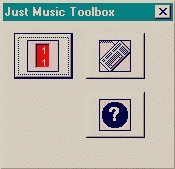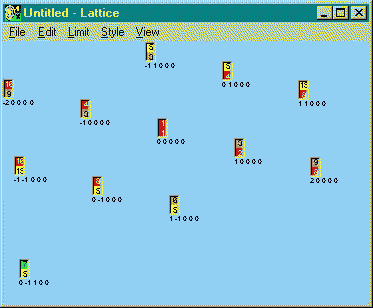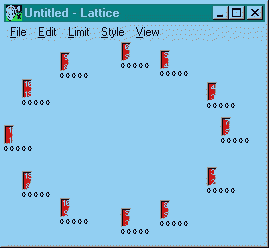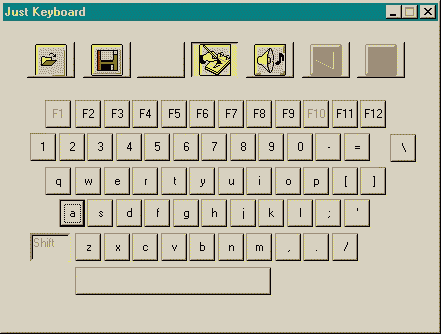GENERAL DESCRIPTION
Joe Monzo's JustMusic software application utilizes lattice diagrams and other graphs for the composition, recording, performance, and analysis of microtonal music.
|
EXAMPLE:
The white parallelogram encloses a
periodicity-block
of 55
8ve-equivalent
5-limit
JI
pitch-classes
as well as a 55-tone 1/6-comma
meantone chain.
This is a 2-dimensional planar representation. Ideally, because
of the way meantones behave and are used, the JI lattice should
be wrapped along the (4 -1) = ratio 81:80
unison-vector
(the southwest-to-northeast axis of the periodicity-block)
into a cylinder. Then the meantone vector would travel thru
the opening in the middle of the cylinder. Better still,
that cylinder could then be wrapped into a torus along
the other axis, since this is a closed tuning system.
|
The goal of this project is to create an application where the user enters a multi-dimensional world projected in 2-D or 3-D space, where musical tuning systems are projected as vectors representing various numerial relationships among the ratios of the pitches of the notes. Using the mouse -- and eventually, more interactive forms of physical engagement between computer and user -- the user can simply draw lines and other shapes in the on-screen world, to record the notes as desired, at the proper time, to create a MIDI or other audio file. In real time as the music plays, the world displays the vectors and other related shapes which represent the notes, and they move and change to reflect the changes in the tuning of the music. Differences between different types of tuning systems are vividly portrayed as different types of lines and shapes. I'd like to make very logical and effective use of color in these worlds as well. (Robert Walker's VRML CPS sets are very closely allied to my ideas.) |
I strongly encourage anyone with a lot of interest in the mathematics of musical tunings to join in this collaborative project and help to create a great piece of really useful software.
TO START
Create a "JustMusic" folder, Download a zip file of everything (including this webpage), and unzip it all into that folder.
If you are a programmer and you would like to work on the JustMusic project, please write me and ask to join the JustMusic discussion group. The old version of JustMusic presented here was written in C++, a newer but less functional version is in VisualBasic, and all future development will probably be in Java.
For individual files:
Download JustMusic, the executable program itself.
This opens a toolbox with 3 buttons.
|
|
The upper-left button, with 1/1 in a red rectangle, opens the Lattice Window. The upper-right button, with the computer keyboard, opens the Keyboard Window. The bottom-left button, with the question-mark, creates and opens an 'About' Window (stored as a webpage called 'Ear43.htm' in your JustMusic directory); this has links to mine and various other related websites. |
The JustMusic Manual
There are a lot of menu choices in all the windows that are not yet implemented. Everything is explained in the official JustMusic Manual. Download it here in a Microsoft Word .doc file; still quite skimpy, but it explains everything that can currently be done.
|
|
In the Lattice Window, the File|New menu choice currently will create a default Monzo lattice that contains an arbitrary choice of ratios. None of the lattice choices do anything yet. The File|Open command, however, will allow you to open any Scala file that is stored on your hard-drive, and will be able to create a lattice of any scale that is rational, within the 13-prime-limit, and has a fairly low exponent-limit. JustMusic will attempt (quite unsuccessfully at this point) to put any irrational scale-members into the lattice. |
Download these Scala files and save them on your hard-drive (they are already included in the zip file given above). You can File|Open them in the Lattice window (they are plain text files which follow Scala conventions; be sure to eliminate the ".txt" extension and replace it with ".scl"):
Harry Partch's 43-tone scale partch-system.scl
An Erv Wilson scale wilson-class.scl
A Monzo 11-limit symmetrical system monzo-sym-11.scl
A scale by Adriaan Fokker fokker-scale.scl
|
|
The Style|Monzo Lattice/Planetary Graph menu choice allows you to view the scale as either a Monzo Lattice, or a Planetary Graph, which puts all the ratios around the circumference of circle according to their Semitone value, the complete circle representing the 'octave'. Suppport for many other lattice styles will eventually be included. |
The Style|Patch menu choice gives a General MIDI list of patches and allows you to choose the sound which will play the ratios.
Clicking on a ratio/lattice-point will play that note, based on a 1/1 of 'middle-C'. Holding the 'SHIFT' key while clicking lattice-points will cumulatively play all those ratios as a chord; as long as 'SHIFT' is held down and the cursor is held over one of the ratios in the chord, it will play the chord (a bug: every other click will eliminate the last-clicked note from the chord...??).
The View|Table menu choice opens a window with an .html file putting the scale into ascending order (from the bottom) and giving various other info about each ratio.
|
|
The Keyboard Window has toolbar buttons rather than menus. It opens in Edit Mode, with the editor button (the one with the hand writing into a notepad) activated; if you press any QWERTY key, it will open the key-editor window and allow you to enter KSL (Keyboard Scripting Language) code, which will tell the key what to play when pressed. This can be single pitches, chords, melodies, or entire polyphonic 'samples'. KSL for each key is entered one-at-a-time. See the KSL document for all the possibilities. |
The button 2nd-from-left (with the picture of the diskette) will save any key-mapping created with the key-editor, as a .jmk ('JustMusic keyboard') file.
The left button (with the picture of the folder) will open a .jmk file stored on disk.
Clicking the button with the picture of the loudspeaker will put the Keyboard Window into Play Mode. You can now play the computer QWERTY keyboard as a monophonic (one key at a time) keyboard instrument.
Click here to open detailed step-by-step instructions on how to map ratios to the computer keyboard.
When the louderspeaker button is activated, it also prepares the two record buttons on the right for use. These will allow you to record a performance on your QWERTY keyboard and save it on disk as a track in a MIDI file, including the appropriate pitch-bend to render the just-intonation.
A sample keyboard layout, which you can 'Open' from the Keyboard Window - File menu: Partch scale keyboard map. (save it as a text file and replace the ".txt" extension with ".jmk")
This maps Harry Partch's rational 43-tone scale (see Genesis of a Music, 1st ed., 1949 or 2nd ed., 1974) to the computer QWERTY keyboard as follows:
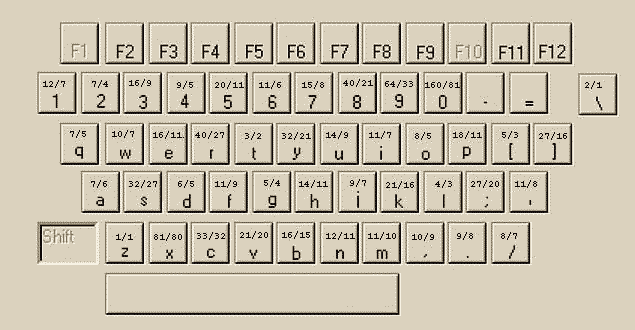
And here is a mapping I made for the Canasta scale.
Some other PC software for JI that you might want to look into: Zarlino, Mutabor, Fractal Tune Smithy, and of course, Csound. Check the wwweb.
SOFTWARE REFERENCES
Breed, Graham. MIDI Relay, Midiconv
deLaubenfels, John. Adaptune [official name?], JI Relay.
Keenan, Dave. Various Microsoft ExcelTM spreadsheets and tuning algorithms.
Op de Coul, Manuel. Scala.
Vercoe, Barry. Csound.
Walker, Robert. Fractal Tune Smithy ("FTS")
 (19 9) PB.gif)
